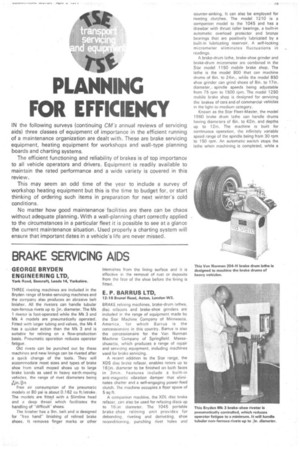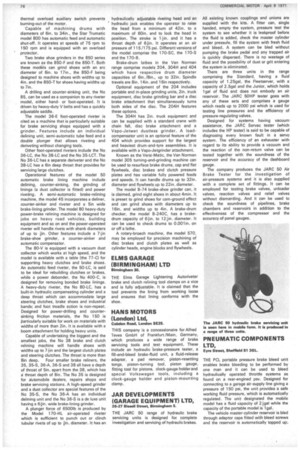E. P. BARRUS LTD,
Page 77

Page 78

If you've noticed an error in this article please click here to report it so we can fix it.
12-16 Brunel Road, Acton, London W3.
BRAKE relining machines, brake-drum lathes, disc refacers and brake-shoe grinders are included in the range of equipment made by the Star Machine Company of Minnesota, America, for which Barrus is the concessionaire in this country. Barrus is also the concessionaire for the Van Norman Machine Company of Springfield, Massachusetts, which produces a range of repair and servicing equipment, including machines used for brake servicing.
A recent addition to the Star range, the XDS disc brake refacer, enables rotors up to 16.;in. diameter to be finished on both faces in 3min. Features include a built-in anti-magnetic vibration damper that eliminates chatter and a self-engaging power-feed clutch. The machine occupies a floor space of 5 sq ft.
A companion machine, the XDL disc brake refacer, can also be used for refacing discs up to 16.in diameter. The 1045 portable brake-shoe relining unit provides for debonding, riveting and deriveting, shoe reconditioning, punching rivet holes and counter-sinking. It can also be employed for riveting clutches. The model 1210 is a companion model to the 1045 and has a drawbar with thrust roller bearings, a built-in automatic overload protector and bronze bearings that are positively lubricated by a built-in 'lubricating reservoir. A self-locking micrometer eliminates fluctuations in readings.
A brake-drum lathe, brake-shoe grinder and brake-drum micrometer are combined in the Star model 1150 mobile brake shop. The lathe is the model 800 that can machine drums of Sin. to 24in., while the model 850 shoe grinder can grind shoes of 8in, to 17in. diameter,-. spindle speeds being adjustable from 75 rpm to 1500 rpm. The model 1250 mobile brake shop is designed for servicing the brakes of cars and of commercial vehicles in the light-to-medium category.
Known as the Star Fleet-Master, the model 1960 brake drum lathe can handle drums having diameters of 6in. to 42in. and depths up to 12in. The machine is built for continuous operation, the infinitely variable speed range of the spindle being from 30 rpm to 150 rpm. An automatic switch stops the lathe when machining is completed, while a
thermal overload auxiliary switch prevents burning-out of the motor.
'Capable of machining drums with diameters of 6in. to 34in., the Star Trumatic model 800 has automatic feed and automatic shut-off. It operates at speeds of 75 rpm to 160 rpm and is equipped with an overload protector.
Two brake shoe grinders in the 850 series are known as the 850-F and the 850-T. Both these models can grind shoes with an arc diameter of Bin, to 17in., the 850-F being designed to machine shoes with widths up to 4in. and the 850-T for shoes having widths up to 7in.
A drilling and counter-sinking unit, the No 85, can be used as a companion to any riveter model, either handor foot-operated. It is driven by heavy-duty V belts and has a quickly adjustable saddle.
The model 36-E foot-operated riveter is cited as a machine that is particularly suitable for brake servicing shops equipped with a grinder. Features include an individual delining unit, semi-automatic tube feed and a double plunger that allows riveting and deriveting without changing tools.
Other foot-operated riveters include the No 36-LC, the No 38-LC and the No 35-LCT. The No 36-LC has a separate deriveter and the No 38-LC has a Sin deep throat that provides for servicing large clutches.
Operational features of the model 50 automatic brake lining machine include delining, counter-sinking, the grinding of linings (a dust collector is fitted) and power riveting. A semi-automatic brake-relining machine, the model 45 incorporates a deliner, counter-sinker and riveter and a Sin wide brake-lining grinder. The model 80 heavy-duty power-brake relining machine is designed for jobs on heavy road vehicles, building equipment and so on and the power-operated riveter will handle rivets with shank diameters of up to 4in. Other features include a 71in brake-shoe grinder, a counter-sinker and automatic compensator.
The 80-V is equipped with a vacuum dust collector which works at high speed, and the model is available with a table (the 77-C) for supporting heavy clutches and brake shoes. An automatic feed riveter, the 50-LC, is said to be ideal for rebuilding clutches or brakes, while a power debonder, the No 400-C, is designed for removing bonded brake linings. A heavy-duty riveter, the No 80-LC, has a built-in hydraulic compensating cylinder and a deep throat which can accommodate large steering clutches, brake shoes and industrial bands; and foot treadle action is non-repeat. Designed for power-drilling and countersinking friction materials, the No 150 is barticularly suitable for work on materials with widths of more than 2in. It is available with a boom attachment for holding heavy units.
Capable of undertaking the biggest and the smallest jobs, the No 38 brake and clutch relining machine will handle shoes with widths up to 7+in and the largest clutch plates and steering clutches. The throat is more than Bin deep. Four smaller brake reliners, the 35, 35-S, 36-A, 36-S and 38 all have a depth of throat of 5in. apart from the 38, which has a throat depth of Bin. The No 35 is designed for automobile dealers, repairs shops and brake servicing stations. A high-speed grinder and a dust collector are special features of the No 35-S, the No 36-A has an individual delining unit and the No 36-S is a de luxe unit having a 6-tin. wide brake-lining grinder.
A plunger force of 65001b is produced by the Model 170-HL air-operated riveter which is sufficient to punch out or clinch tubular rivets of up to lin. diameter. It has an hydraulically adjustable riveting head and an hydraulic jack enables the operator to raise the head from a minimum of 42in. to a maximum of 60in. and to lock the head in position. The stroke is 1 lin. and it has a throat depth of 64in. It operates at an air pressure of 11 5 /175 psi. Different versions of the model comprise the 170-SC, the 170-S and the 170-B.
Brake-drum lathes in the Van Norman range comprise models 204, 304H and 404 which have respective drum diameter capacities of ein./8in., up to 32in. Spindle travels are Bin. 14in. and 16in respectively.
Optional equipment of the 204 includes portable and in-place grinding units, 2in. truck equipment, disc brake grinding bar and a disc brake attachment that simultaneously turns both sides of the disc. The 204H features these options.
The 304H has 2in. truck equipment and can be supplied with a standard crane with chain fall, disc brake attachment and a Vapo-Jetwet dustless grinder. A loadcompensator unit is an optional feature of the 404 which provides support for the largest and heaviest drum-and-tyre assemblies. It is available with a Vapo-Jetgrinder attachment.
Known as the Versi-Matic, the Van Norman model 305 turning-and-grinding machine can be used to resurface brake drums, cap and flat flywheels, disc brakes and clutch pressure plates and has variable fully powered feeds and speeds. It can handle drums up to 32in. diameter and flywheels up to 22in. diameter.
The model 8-74 brake-shoe grinder can, it is claimed, grind eight shoes in about 4min. It is preset to grind shoes for cam-ground effect and can grind shoes with diameters Up to 16in. and widths up to 4in. A brake-drum checker, the model B-240C, has a brakedrum capacity of 61in. to 12kin. diameter. It can be used to check drums to 0.001in. on or off a lathe.
A rotary-broech machine, the model 570, may be employed for precision machining of disc brakes and clutch plates as well as cylinder heads, engine blocks and flywheels.




































































































































